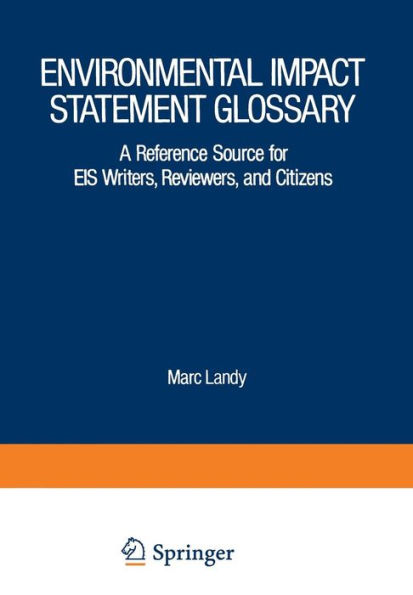Environmental Impact Statement Glossary: A Reference Source for EIS Writers, Reviewers, and Citizens
This reference book sets out to provide a useful glossary to writers, reviewers and citizens interested in the EIS process. Over the last decade, environmental impact statements have developed a rich, but sometimes confusing vocabulary. The purpose of this book is to help people understand and communicate more effec tively by presenting, analyzing and comparing terminology used by various EIS organizations. This book is not a technical glossary or the standard glossary, but rather the first complete effort to assemble and examine the translation of complex technical EIS language into a vocabulary aimed directly at the lay reader. Two major factors are responsible for the confusion over EIS terminology: the diversity of professional vocabularies and multiple interpretations of federal regulations. Due to the di versity and breadth of professional jargons needed to describe the wide range of EIS subject matter, both quantitatively and qualita tively, EIS terminology has become a complex amalgam of profession al languages. The second factor of multiple interpretations of federal regulations contributes to the confusion over EIS procedur al terminology—providing a disjointed vocabulary charged with in dividual interpretation. As a ~esult of this complexity and con fusion, the need for a uniform or standard terminology has been advocated by many organizations, ranging from the Council on En vironmental Quality on the federal level, down to city planning departments on the local level.
1115129276
Environmental Impact Statement Glossary: A Reference Source for EIS Writers, Reviewers, and Citizens
This reference book sets out to provide a useful glossary to writers, reviewers and citizens interested in the EIS process. Over the last decade, environmental impact statements have developed a rich, but sometimes confusing vocabulary. The purpose of this book is to help people understand and communicate more effec tively by presenting, analyzing and comparing terminology used by various EIS organizations. This book is not a technical glossary or the standard glossary, but rather the first complete effort to assemble and examine the translation of complex technical EIS language into a vocabulary aimed directly at the lay reader. Two major factors are responsible for the confusion over EIS terminology: the diversity of professional vocabularies and multiple interpretations of federal regulations. Due to the di versity and breadth of professional jargons needed to describe the wide range of EIS subject matter, both quantitatively and qualita tively, EIS terminology has become a complex amalgam of profession al languages. The second factor of multiple interpretations of federal regulations contributes to the confusion over EIS procedur al terminology—providing a disjointed vocabulary charged with in dividual interpretation. As a ~esult of this complexity and con fusion, the need for a uniform or standard terminology has been advocated by many organizations, ranging from the Council on En vironmental Quality on the federal level, down to city planning departments on the local level.
109.99
In Stock
5
1

Environmental Impact Statement Glossary: A Reference Source for EIS Writers, Reviewers, and Citizens
538
Environmental Impact Statement Glossary: A Reference Source for EIS Writers, Reviewers, and Citizens
538Paperback(Softcover reprint of the original 1st ed. 1979)
$109.99
109.99
In Stock

Product Details
| ISBN-13: | 9781468461107 |
|---|---|
| Publisher: | Springer US |
| Publication date: | 03/28/2012 |
| Series: | IFI Data Base Library |
| Edition description: | Softcover reprint of the original 1st ed. 1979 |
| Pages: | 538 |
| Product dimensions: | 6.69(w) x 9.61(h) x 0.04(d) |
From the B&N Reads Blog
